Beyond the Barline
My Summer at Camp—Part 1
Question: What is Metasynth?
- An open-ended synthesis and sample processing platform with a unique visual interface.
- Air control.
- One very cool app!
- A mega phat software synth.
- A multidimensional, deep sound exploration and composition tool.
- A wondrous tool allowing an individual to tap into the limitless reaches of sound.
-
A super diggidy dope software synth, which allows users to define a seemingly endless number of parameters and create!
- A system which converts graphics into sounds.
- A mega sampler, player, sample editor, paint program, FM synthesizer, and an integrated thousand pixel and sound oscillation monster!
- The most creative music program I’ve ever seen.
- A powerful tool for creating, manipulating, translating, and simulating sound design and synthesis.
- A sound design tool, sampler, and instrument design tool with incredible power and flexibility to fit any music creation technique or style.
- A paradigm shift into infinite possibilities. A metaphor that encourages exploration, growth, and deep listening. Serendipitous composition.
- Metasynth is like vodka: it completely takes on the taste of whatever you put with it and totally enhances the taste!
Those are the opinions of a random cross-sample of users (I wrote the first one, by the way) that gives you some idea of both what Metasynth does and the enthusiasm it generates among both novices and experts.
And Now for Some Background
U & I Softwareis a company founded by French-born programmer, visual artist, and musician, Eric Wenger, out of a desire to build a sound design application that could take advantage of the latest Macintosh technology. Why, he asked himself, did Soundesigner II, Digidesign’s venerable stereo digital editing application, still record destructively to disk? Why did it still represent sound in monochrome? (Updates had limited colors.) Why did it offer so few DSP options? Wenger realized he could write a more flexible and up-to-date application himself, while incorporating his background in visual design software, such as Bryce which he co-designed with Kai Krause, the co-founder of MetaTools (now MetaCreations). The result was Metasynth.
What’s Special About Metasynth?
Well, as I said in my description, Metasynth is “an open-ended synthesis and sample processing platform with a unique visual interface.” The most important adjective for me in that statement is “open-ended.” I’ve come to realize lately that there are two kinds of music software (and I’m sure this goes for visual design software too). Closed systems—like sequencers, hard disk recorders, software synths, or samplers—are designed to perform a specific task. The best among these combine elegance and versatility, but they are ultimately restricted by the function they serve. Open systems—examples include Metasynth, Kyma, and Max—provide a paradigm, but do not prescribe the results. It is possible, and actually quite likely, that you will realize something in these programs that the software designers never envisioned. A MIDI sequence, however interesting, is still a MIDI sequence.
It is also no surprise that these open-ended applications are all made by smaller companies. Yes, Max was acquired by Opcode in 1990, but David Ziccarelli took the application with him to Cycling ’74 (and regained all the rights from Gibson recently), and now answers his own tech support e-mail. Carla Scalletti, the founder of Symbolic Sound, will personally talk you through Kyma crises on the phone, and Eric Wenger, along with Edward Speigel (who joined U & I recently) who run the company booth at Macworld SF themselves, post responses regularly to the U & I mailing list, and take time out of their schedules for events like the Metasynth Camp. The combination of flexible, open-ended software, and personal attention has built each of these companies a fiercely loyal following.
How the Camp Came to Be
Andy Lefler, a glass blower turned digital artist, was brought to the U & I mailing list through his passion for Artmatic, a wonderful and inexpensive fractal art and animation program also created by Eric Wenger. Lefler became increasingly interested in Metasynth through discussions on the list, and was the one who originally floated created the idea of bringing a group together to learn more about the program. Several ideas were proposed, various locations, even an online gathering, but in the end Todd Barton (of Southern Oregon University, and also the Music Director of the Oregon Shakespeare Festival) secured the Media Center in the SOU Department of Music, and Metasynth Camp was born. I wasn’t on the U & I mailing list at the time, but Todd contacted me (he has a long standing relationship with Future Music Oregon) and, given that Ashland is only a three-hour drive from Eugene, I jumped at the opportunity.
Getting to Know You
We all met at the Media Center at 8 PM Thursday. Todd had everyone introduce themselves, and I quickly realized that I was one of the “youngsters” of the group. The most common statement was, “Well I started in the ’70s with a Moog (or Buchla, or Surge, or some other analog synth).” Yes, some of my early experiences were with modular analog synths, but they were practically museum pieces by this point, and I was learning MIDI sequencing at the same time.
Then Todd showed us the lab, and we each claimed a workstation with a 266 MHz G3 all-in-one (a rare predecessor to the iMac that was only sold to schools) and some MIDI gear that was inconsequential in terms of our work with Metasynth. The presentation setup in front of the room consisted of a 450MHz G4 running a video feed to a projector.
Todd also showed us the camera setup that would be used to videotape the entire weekend: three cameras, plus a FireWire feed from the G4 for capturing video and audio signals mixed together from the G4 and a live microphone. Little did we know it then, but the camera crew, led by Greg and Mariko Moore, would have their hands full all weekend. The G4 would crash Friday afternoon and be replaced by Greg’s Blue and White G3 350, and they would then have to improvise connections until the G4 was working again.
We wrapped up early (about 9:15, the only day we would) and I headed back to the SOU dorms, which were pretty good accommodations for the price ($24.50 a night). There I downloaded my e-mail on my Visor (putting the modem I reviewed to good use), wrote a quick note to my girlfriend (she was in Indiana for her high school reunion), and raided the snack machines downstairs. Tomorrow morning would come bright and early, but with the heat I didn’t get much sleep.
Friday Morning—The Basics
We began Friday morning where most begin in Metasynth, the image synth. Todd gave a demonstration and we all built a few simple examples. The one I’ll cover here illustrates a simple way to build drum patterns. The image synth includes a “grid” setting which, combined with a repeating “brush mode,” lets you easily draw pulses which you can build into more complex rhythmic patterns. The first example shows a basic pattern. Time is mapped horizontally, and pitch is mapped vertically. Red is left, green is right, and yellow is in between. Blue in this case marks the basic pulse (the “Blue Channel” has many uses, but it never produces sound on its own).
 |
Note the sine wave icon in the Image Synth window. As you can hear, if you download the linked MP3 file, the pattern is mapped to a simple sine wave oscillator (set in the Wave Table window). In the next example, I have done two things—first I added a syncopated pattern above the original top line, then I remapped the pattern to a drum kit. Unlike Todd’s example, where the top two lines are mapped to a high-hat, my version mapped the same pattern to a bass drum.
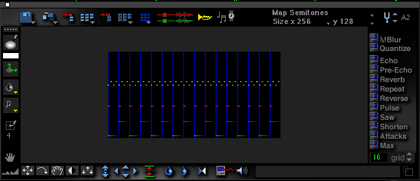 |
I liked the driving “techno” feel of the fast bass pulse, but was missing a high-hat, so I added one; and, using a filter from the preset file, shifted it into a three-against-two pattern. I added a stereo filter (from the same set of presets) to both the high-hat and bass drum to get the following result.
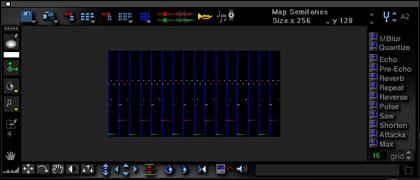 |
We then moved to the Filter window, which analyzes sound files generated from the Image Synth (or any other source) and applies graphic filters to them. Todd showed us a number of different filter patterns. The example I give here is a gradual filter sweep up through the total frequency range.
 |
I doubled the pattern’s length before filtering so that the fade in would be more gradual. The resulting sound file might serve as an introduction to a longer work. Todd’s own example, “Beat Study 2,” is available on his Metascape page at MP3.com. Note the similar, though differently mapped, drum pattern, as well as the use of filters, panning, and some of the synthesized sounds possible in Metasynth.
More Basics
Glen Bledsoe, the founder of the Metasynthia Project, led the second half of the morning seminar. He demonstrated how to build simple melodies in the image synth through a combination of Scale Maps, the “fit to scale” option, and the various tools in the image synth window. Following along I created this little sax lick.
Not bad, but rather inexpressive. Next, Glen demonstrated how to modify the pitch envelopes of each note.
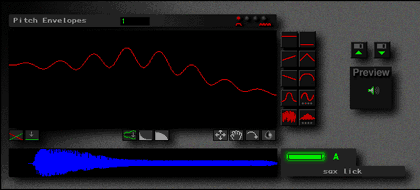 |
|
A Simple Vibrato |
It’s tedious work, but with a little patience and a lot of sensitivity you can bring some level of expression out of preset samples. Layering melodies like these with rhythmic patterns, Glen realized the quirky jazz-influenced compositions he distributes under the pseudonym Professor Armchair.
Build Your Own Filter
Friday afternoon Eric Wenger demonstrated the numerous graphic tools available in the Image Synthesizer. These tools have many applications in the unique visual/sonic world of Metasynth, one of the most intriguing of which, for me, is filter design. Here is a step-by-step example:
 |
By inverting the black screen while in stereo mode, I produced a yellow screen representing a transparent filter. Then I applied a preset mono filter to this stereo image, creating a stereo duplicate, mapped equally to the left and right channels.
 |
Using the Displacement Map on the left channel only, I distorted it to create a new pattern:
 |
Then I applied a different displacement map to the right channel. The result is a new filter pattern that I can save in a new filter preset file. It’s also a pretty cool picture:
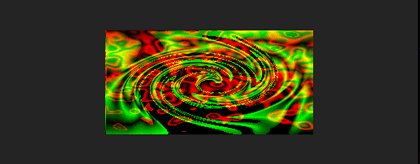 |
The Quest for a Better E-mail Connection
Unfortunately, Eric’s presentation was interrupted by the aforementioned G4 crash. I used the unscheduled break as an opportunity to find the computer lab and check and reply to my e-mail in a more comfortable setting. I didn’t plan to stay long, but when I arrived, I found out that the computer lab would be closing at 5:00 PM (it was now almost 4:00) for the weekend. At the time, I thought this would be my only chance to respond to my accumulating e-mail at length (writing in Graffiti tests my patience rather quickly), so I chose to miss the rest of the afternoon session.
I was also exhausted so I went up to my room after dinner and unexpectedly fell asleep. I was late for the evening session, but Todd dedicated the first hour to rudiments, so I was able to begin working quietly on a work of my own, which I will describe in detail next month. I thought that my e-mail problem had been solved, when Edward introduced me to mailstart.com, a great site that allows you to check any e-mail account. That worked until halfway through the Saturday session, when Netscape stopped functioning and ended up crashing my computer. It turned out that the same problem had suddenly struck all the computers, and Todd suspected that the university had blocked Internet access for the weekend. What did I ever do to them?
Saturday—More Tips and Tricks
In between working on my own piece most of the day (I was becoming more and more inspired by all the ideas swirling around me) I caught the highlights of various presentations. Todd built a short piece out of a shakuhachi sample that he made the previous evening, and a simple percussive pop, which he expanded, through added harmonics, into a convincing drum sound. Glen showed how to set up a custom scale in a SimpleText file, either by cents or by acoustic ratios, and open it in the Custom Scale map. (There are 400 scales on the Metasynth CD, by the way). Edward demonstrated various types of analysis/re-synthesis, including a way to build a custom scale out of a harmonic analysis. Finally, Eric demonstrated the many applications of the Blue Channel. We have already seen the Blue Channel at work in our drum grid, but it has many other uses. Perhaps Eric’s most striking example was when he took an analysis, copied it to the Blue Channel, then took a second analysis and pasted it to the Blue Channel. The result was a combination of the amplitude envelope of analysis one with the harmonic content of analysis two, or in other words, a vocoder.
Transformation Beyond Recognizability
Part of Edward’s demonstration showed the incredible flexibility of the Effects window. Taking a simple sample, a woman reading the text Welcome to Metasynth, he led us through a series of transformations that gradually distorted this sample beyond recognizability. First he scrambled the sample through granulation. (What you hear is actually two passes with slightly different settings.) Granulation can also be used to stretch sounds. In Metasynth, the ratio of time change is set by the ratio of output to input. Edward then used reverberation to blur the individual grains. After two passes, the result is sufficiently smoothed out. Then he added the following effects: resonance, which highlights certain harmonics in the sample, and the shuffler which scrambles the sample and makes instant rhythmic patterns. Finally, I added the inertia effect myself. It smears and emphasizes the low frequencies, and it is one of my personal favorites.
 |
|
The Effects Window |
Go back now and compare the final MP3 file with the original. Some of the original vocal quality remains, but the material is so distorted that no one could ever guess the exact content of the original. This approach to sample modification has always fascinated me, and I see Metasynth’s abilities in this area as one of its strongest points.
Saturday Night—Time to Share
A number of works were presented Saturday night including my own newly realized composition. I will take you through each step of its construction next month, as well as cover the last morning of presentations and relay my impressions of the Videodelic demo. For now, I encourage you to visit the Metasynth site, check out the various audio (Metasynth, Metatrack, Xx) and video (Artmatic, Vidoedelic, Bryce) examples. Further examples by Eric Wenger, Edward Speigel, Todd Barton, and Glen Bledsoe are available for download on MP3.com.
Next Month: My Summer at Camp—Part Two.
Also in This Series
- Ready or Not! · November 2002
- The Other Petition · August 2002
- The Samples Have Been Changed to Protect the Innocent · May 2002
- Record Execs Ate My Hard Drive! · April 2002
- And the Award Goes to… · March 2002
- Expos, From a Distance · February 2002
- My Resolution · January 2002
- Too Much Hype · November 2001
- And They’re Off! · September 2001
- Complete Archive
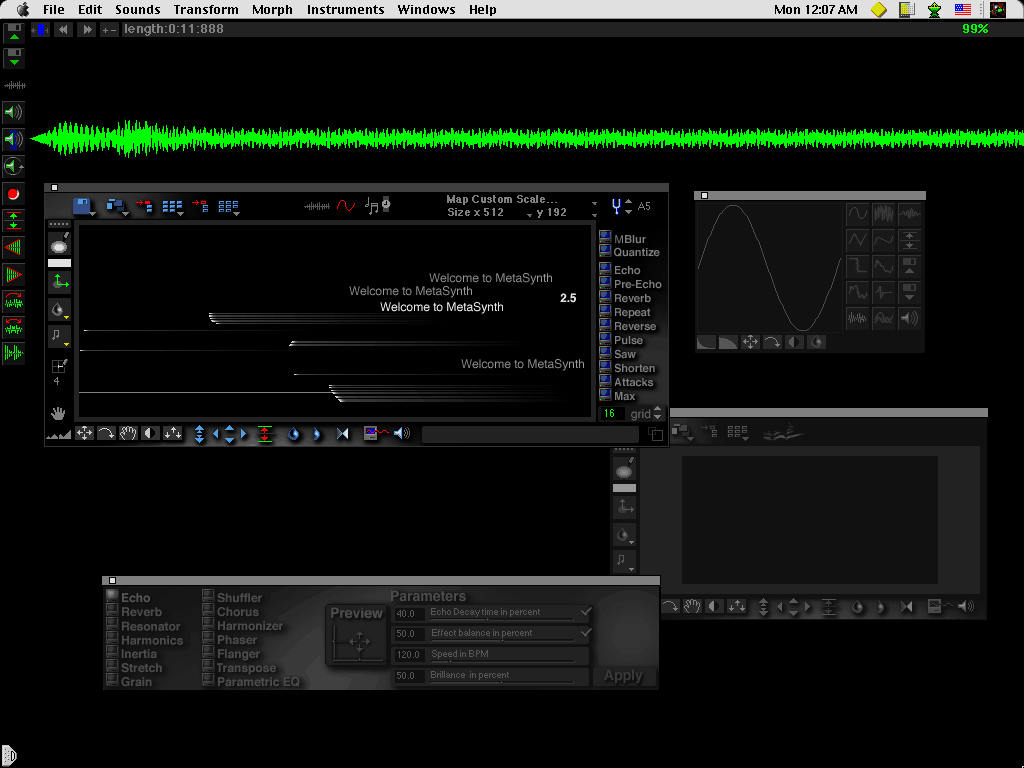
Reader Comments (0)
Add A Comment